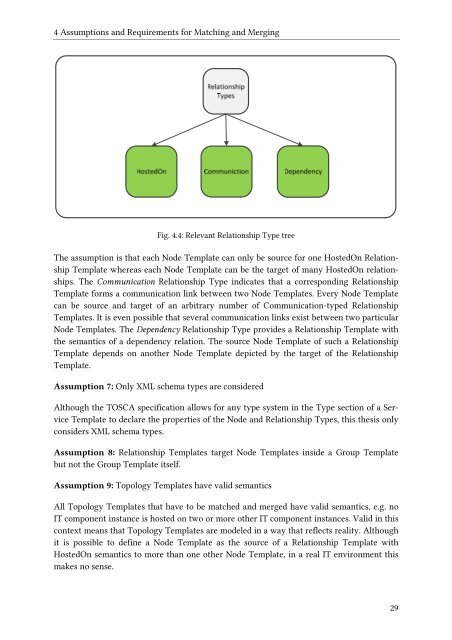Merging of TOSCA Cloud Topology Templates - IAAS
Merging of TOSCA Cloud Topology Templates - IAAS
Merging of TOSCA Cloud Topology Templates - IAAS
You also want an ePaper? Increase the reach of your titles
YUMPU automatically turns print PDFs into web optimized ePapers that Google loves.
4 Assumptions and Requirements for Matching and <strong>Merging</strong><br />
Fig. 4.4: Relevant Relationship Type tree<br />
The assumption is that each Node Template can only be source for one HostedOn Relationship<br />
Template whereas each Node Template can be the target <strong>of</strong> many HostedOn relationships.<br />
The Communication Relationship Type indicates that a corresponding Relationship<br />
Template forms a communication link between two Node <strong>Templates</strong>. Every Node Template<br />
can be source and target <strong>of</strong> an arbitrary number <strong>of</strong> Communication-typed Relationship<br />
<strong>Templates</strong>. It is even possible that several communication links exist between two particular<br />
Node <strong>Templates</strong>. The Dependency Relationship Type provides a Relationship Template with<br />
the semantics <strong>of</strong> a dependency relation. The source Node Template <strong>of</strong> such a Relationship<br />
Template depends on another Node Template depicted by the target <strong>of</strong> the Relationship<br />
Template.<br />
Assumption 7: Only XML schema types are considered<br />
Although the <strong>TOSCA</strong> specification allows for any type system in the Type section <strong>of</strong> a Service<br />
Template to declare the properties <strong>of</strong> the Node and Relationship Types, this thesis only<br />
considers XML schema types.<br />
Assumption 8: Relationship <strong>Templates</strong> target Node <strong>Templates</strong> inside a Group Template<br />
but not the Group Template itself.<br />
Assumption 9: <strong>Topology</strong> <strong>Templates</strong> have valid semantics<br />
All <strong>Topology</strong> <strong>Templates</strong> that have to be matched and merged have valid semantics, e.g. no<br />
IT component instance is hosted on two or more other IT component instances. Valid in this<br />
context means that <strong>Topology</strong> <strong>Templates</strong> are modeled in a way that reflects reality. Although<br />
it is possible to define a Node Template as the source <strong>of</strong> a Relationship Template with<br />
HostedOn semantics to more than one other Node Template, in a real IT environment this<br />
makes no sense.<br />
29
















